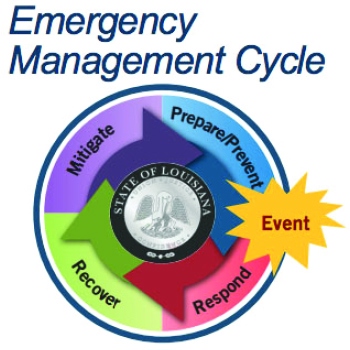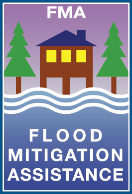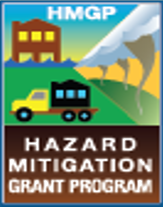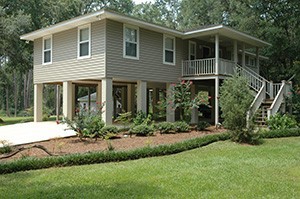Hazard Mitigation Overview
We cannot control when or where a disaster strikes — but we can save lives and reduce property damage by understanding risks and taking action to address those risks. In the process, we help our families and increase resilience in our communities, environment and economy. Resilient communities are able to minimize any disaster, making the return to normal life as quickly and effortless as possible.
Hazard Mitigation (HM) is the sustained effort to reduce or eliminate long-term risk to life and property by lessening the impact of a disaster. It is taking action now – before the next disaster – and requires understanding natural and man-made risks and their effects. This definition distinguishes actions that have long-term impacts from those that are more closely associated with immediate preparedness, response and recovery activities.

Mitigation’s role in the emergency management cycle
Hazard mitigation is the only phase of emergency management specifically dedicated to breaking the cycle of damage, reconstruction and repeat damage.
Guided by principles outlined in the National Mitigation Framework (Framework) and enabled by the Louisiana Homeland Security and Emergency Assistance and Disaster Act (Louisiana Disaster Act), GOHSEP plays an important role in helping local communities, State agencies and other eligible entities identify and implement mitigation initiatives. GOHSEP mitigation staff are poised to provide assistance and expertise to communities and eligible entities in project identification, sub application development, programmatic/policy guidance, planning, grants management, monitoring and close-out of activities.
Local HM initiatives are important. Because they are taken before the next disaster, they reduce vulnerability so that communities are better protected from the impacts of a disaster and are able to recover more quickly should a disaster occur. Mitigation initiatives break the cycle of damage, reconstruction and repeat damage.
Recognizing that stronger, more resilient communities reduce the impacts of disasters, resulting in recoveries that are less costly, the Federal Government makes investments in HM initiatives by providing grants to assist communities to implement HM projects both pre-disaster and post disaster.
National Mitigation Framework (Framework)
Understanding the strengthening of our communities, States and Nation is a shared responsibility. The National Mitigation Framework has been created to foster a culture of resiliency. The Framework provides context for how the whole community works together to become safer, stronger and more resilient. It provides a common platform and forum for coordinating and addressing how we manage risk through mitigation. The Framework describes mitigation roles across the whole community and addresses how we develop, employ and coordinate core mitigation capabilities to reduce loss of life and property by lessening the impacts of disasters.
Hazard Mitigation Assistance (HMA) Programs
The Federal Emergency Management Agency (FEMA) provides funding for eligible mitigation activities through three Hazard Mitigation Assistance (HMA) grant programs. Two are available on annual funding cycles and are not related to a disaster event. The other is funded in response to a Presidentially declared disaster.
Non-Disaster Mitigation Grants

PDM is authorized by the Robert T. Stafford Disaster Relief and Emergency Assistance Act (Stafford Act), 42 U.S.C. 5133 and is funded by congressional appropriations typically on an annual basis. PDM funding is focused on eligible activities that assist the State is in reducing the risk to population and structures in future hazard events.

FMA is authorized by Section 1366 of the National Flood Insurance Act of 1968 (NFIA) as amended (NFIA), 42 U.S.C. 4104c and is funded by the National Flood Insurance Fund (NFIF) as appropriated by Congress. FMA funding is focused on eligible activities that reduce or eliminate flood insurance claims.
Post-Disaster Mitigation Grants

Hazard Mitigation Grant Program (HMGP) – is referred to as 404 mitigation because it is authorized under Section 404 of the Stafford Act.
406 Mitigation – mitigation funding through the FEMA Public Assistance (PA) Program identified in Section 406 of the Stafford Act.
HMGP (and 406) is authorized by Section 404 of Stafford Act, 42 U.S.C. 5170c and is available when authorized under a Presidential major disaster declaration. The amount of funding available to the State is calculated by FEMA based on a percentage of the estimated Federal assistance provided after a disaster as outlined in 44 CFR 206.432(b).

Eligible Activities
Hazard mitigation projects are intended to strengthen facilities and communities, making them less vulnerable to future disaster impacts. Examples of typical mitigation activities are listed below. Eligible activities differ by HMA program and may change based on changes in FEMA guidance over time. Please review the FEMA HMA webpage for specific activities or contact GOHSEP to discuss any questions.
- Elevation of flood-prone structures – physically raising an existing structure above the base flood elevation (BFE) or higher.
- Acquisition of flood-prone structures – “buyout” of structures and converting land to green space in perpetuity.
- Localized drainage improvements – reduce localized flooding by increasing drainage capacity.
- Safe room construction – provides immediate near life-safety protection for either tornado or hurricane winds.
- Wind retrofit of structures – hardening the envelope of a structure to protect against high wind loads. The envelope is the shell of the structure (including the doors, roof covering windows and walls) that maintains a dry, heated or cooled indoor environment.
Roles + responsibilities
States, territories, and federally-recognized tribes are eligible Applicants for HMA programs. When funding is awarded, the Applicant then becomes both the Recipient and the pass-through entity. A Recipient receives a Federal award directly from FEMA to carry out an activity under the HMA program. A pass –through entity provides a sub-award to a sub recipient.
In Louisiana, GOHSEP is the State agency responsible for reviewing and submitting HMA sub applications to FEMA.
The Sub applicant is a State level agencies, federally recognized tribe, local government, or other eligible entity that submits a sub application for FEMA assistance to the Applicant. When HMA funding is awarded the sub applicant becomes the sub recipient and is responsible for managing the sub-award and complying with the program requirements and other applicable Federal, State, territorial, tribal, and laws and regulations. Sub applicants are responsible for preparing and adopting a Hazard Mitigation Plan (HMP) that identifies risks and strategies to address those risks. Sub applicants submit HMA applications to GOHSEP when funding opportunities are announced based on the priorities and strategies identified in their approved HMP.
When funding opportunities are available, GOHSEP staff is available to assist sub applicants with developing sub applications prior to submission. GOHSEP also reviews local HMPs and submits them to FEMA for approval. An approved plan is an eligibility requirement for HM grants.
GOHSEP Hazard Mitigation Structure
The GOHSEP State Applicant Liaison (SAL) section is responsible for assisting sub applicants and with sub application development, reviewing project sub applications and assisting FEMA during the sub application and amendment approval process.
The Grants Management section is responsible for assisting sub recipients with reimbursement questions, reviewing and processing reimbursement requests, and reviewing Quarterly Report submissions.
The Closeout section is responsible for working with sub recipients and FEMA to administratively close completed projects timely.
The Technical Services section is responsible for HM planning assistance, helps to ensure wise investments of mitigation funding through benefit-cost analysis (BCA) assistance, policy, training and agency collaboration.
Eligible Activities
HMGP
PDM
FMA
Property Acquisition and Structure Demolition
Property Acquisition and Structure Relocation
Mitigation Reconstruction
Dry Flood proofing of Historic Residential Structures
Dry Flood proofing of Non-Residential Structures
Localized Flood Risk Reduction Projects
Non-Localized Flood Risk Reduction Projects
Structural Retrofitting of Existing buildings
Non-Structural Retrofitting of Existing Buildings and Facilities
Wind Retrofit for One and Two Family Residences
Post Disaster Code Enforcement
Planning Related Activities






